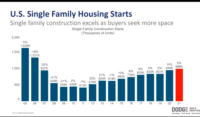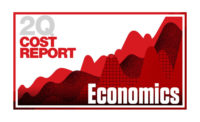Amid the ongoing recovery, the pandemic continues to set the course for overall economic activity, said Richard Branch, chief economist at Dodge Construction Network, in a quarterly construction starts forecast on Feb. 15.
“The Delta wave weighed on growth and fanned inflation significantly back in the fall, and Omicron certainly took a bite out of activity over the last month-and-a-half to two months,” said Branch. Going forward, however, “we continue to assume that each subsequent wave of COVID infection will be less disruptive to the healthcare system and the economy than the previous one.”
After a soft 2022 first quarter due to Omicron, Branch expects a sharp rebound in the second quarter, despite ongoing issues with inflation and labor shortages.
Overall, Dodge forecasts a 9% boost in construction starts this year. “I think that we are going to see a much more broad-based growth here in 2022 across the sectors [than in 2021],” said Branch.
Residential sector starts, measured in number of units, are expected to rise 3% after a sharp increase of 14% in both 2020 and 2021. Multi-family construction is set to increase 2% following a 23% boost in 2021. “Multi-family has really just been on a tear over the last six to eight months,” said Branch, with the largest area of growth n mid-size buildings.
Commercial construction is expected to rise 15% in 2022 after a 13% increase in 2021. “On the surface, the commercial sector stages a pretty solid recovery in 2021,” said Branch, but notes that “it was fairly uneven, and really driven by the warehouse sector.”
Dodge forecasts that recovery will even out across the sector in 2022, with retail, office and hotel expected to rise at 20%, 12% and 18%, respectively.
Warehouse construction continues to be a “Goliath,” says Branch, predicted to rise another 17% this year, with manufacturing up 9%. That sector "is where we’ve seen probably the biggest upgrade to our forecast,” he said. pointing to current supply chain issues as a catalyst for the increase. “Domestic producers are going to want to have more flexibility in terms of sourcing product,” said te economist.
In the institutional sector, an 11% increase is expected. After a flat 2021, education starts are set to rise 13%, which Branch attributes to confidence that students are unlikely to return to remote learning. Healthcare work is also expected to increase, at a rate of 14%.




